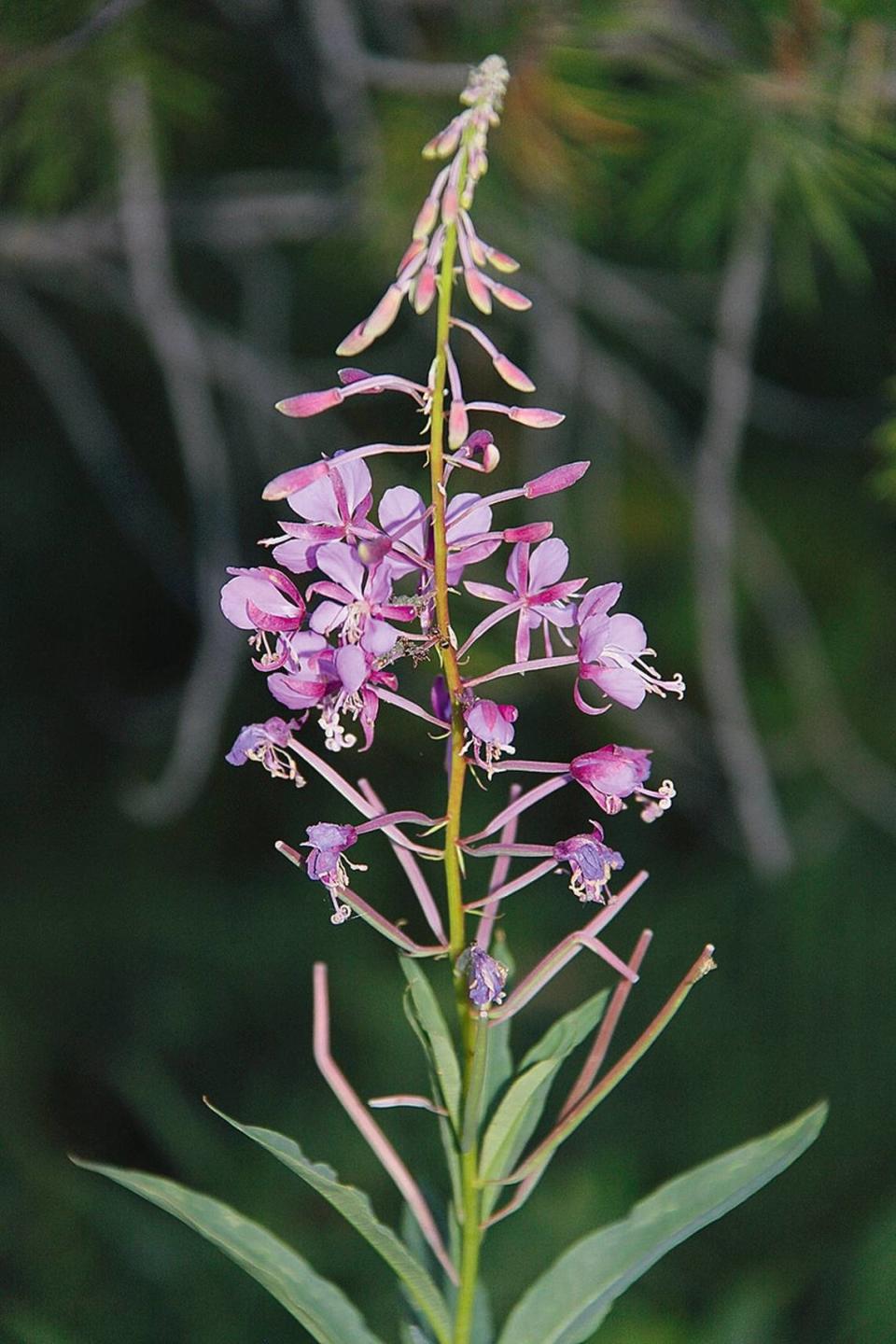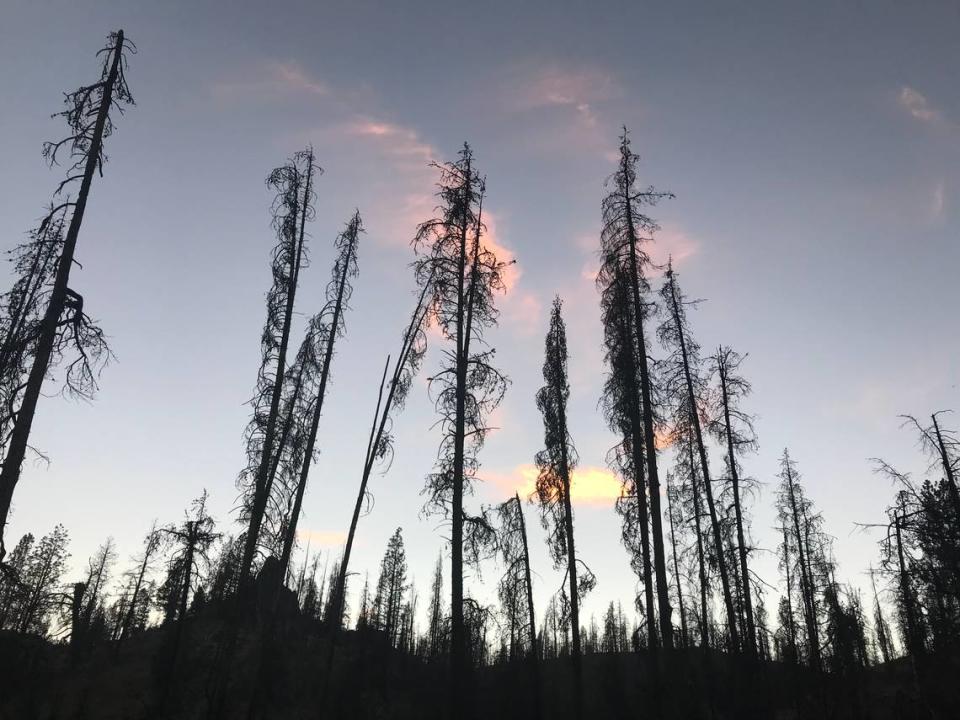These tasty edible plants need wildfires to thrive. Why do they appear in burn areas?
In the year after a fire, hundreds of morels per acre appear in burned areas. So do foragers looking for these beloved mushrooms.
Right now, 13 large fires burn in Idaho. But after they’re done smoldering, they’ll leave behind an area ripe for edible, harvestable foods.
Morels are “one of the most prized delicacies that can be commonly found throughout Idaho,” said Jonathan Oppenheimer, a wildfire management expert at the Idaho Conservation League and an amateur forager, by phone.
It’s not just mushrooms that emerge from ashes. Edible fireweed, camas, and berry-producing shrubs like huckleberries all thrive after a fire clears an area for them. The forests themselves need wildfires for regeneration, according to Oppenheimer.
Even when a wildfire leaves behind an ashy black landscape, it doesn’t kill everything in its path. Mushrooms emerge in burn areas because they’re the reproductive parts, like a fruit, of organisms underneath the ground. These organisms, which are more closely related to yeasts and molds than to plants or animals, can’t convert sunlight to energy.
In a living forest, some fungi, which produce mushrooms, partner with trees. The trees provide sugars to the fungi, and the fungi help the trees get water and other nutrients from the soil.

Though he stressed that there isn’t yet enough research to be sure, he believes that when a fire kills all the trees that morels usually feed from, “it’s in the fungus’s best interest” to move its offspring to greener pastures. So, it produces mushrooms, whose spores can be carried far away toward living trees.
A 2016 study of his found that, in the year after a fire, burn morels were much more likely to appear in small patches that were completely burned than in ones that still had some trees alive.
Larson suggested foragers look for morels within about a year of a fire in burn areas where most of the trees died. He’s noticed that morels sprout in small areas with slightly moister soil, such as flat spots in the land. This is probably because the fungus needs some moisture to produce the mushrooms. The best way to find morels, he said, is to look within 15 or 20 feet of other morels. Larson speculated that this is about the size of the organism underneath the ground.
Fireweed, other plants thrive after burns
Krista Willmorth, president of the Southern Idaho Mycological Association who also runs a foraging blog, recalled a luncheon she attended in 2019 in the middle of a burned forest near Idaho City.

They sat on a table plunked down in the middle of the flowers and ate lunch on a pink tablecloth that matched the flowers’ petals.
Wildfires burn at different temperatures and intensities. Depending on the conditions, some organisms survive below the surface. One of the first to appear in burn areas, within just weeks of fires, is the aptly named fireweed, which grows from buds on roots below the surface.
While wildfires might burn the parts of the plant above the surface, these roots remain. After the fire, the fireweed spreads seeds to grow further and make more pink flowers.
At the lunch, Betsy Hinze, who writes about foraged foods under the name Miss Wondersmith, gave fellow diners fireweed jelly, which she’d made from the plant’s flowers. She also taught them how to make tea from its leaves. After crushing the leaves, Willmorth fermented them for a few days.
The tea had notes that resembled black tea, though it had “slightly funky odors,” she said.
Other edible plants, such as the common camas, can regrow after wildfires from buried bulbs.

Since camas needs a lot of sunlight, in forested regions, it tends to grow only in areas disturbed by fires.
Camas plants must be cooked before they’re eaten so that indigestible parts of the plant are broken down into more palatable sugars.
“It must have been thousands and thousands of years to figure something out,” Miles mused. “Somebody had to get sick trying something. … Some things have to be processed – they’re naturally poisonous.”
Fires also clear a path for much-needed sunlight to reach shrubs that produce edible berries, though it can take around 10 years to see these fruits. Fruit-bearing shrubs such as raspberries, thimbleberries, blackberries and huckleberries can sprout from underground stems after a fire.

“Typically, your best huckleberry patches are not going to be under a dense forest canopy – they’re going to be on edges or out in open areas in old burns, even alongside a road,” said Larson, the forest ecologist.
Native, edible plants emerge after wildfires only if they’re not beaten out by invasive species. In the Foothills of Boise, Miles said, “you burn up the noxious invasive weeds, and all you’ve done is allowed it to come back again. It just comes back fuller the next time.”
Native foods are harvested after wildfires
Many other native plants in Idaho are edible. Yet, figuring out which plants someone can eat and how to identify and prepare them is no easy task.
Most mushroom and huckleberry hunters won’t tell newcomers where to look because they don’t want competition.
Many families in the Nez Perce Tribe are also reluctant to share information about native foods because “we’ve seen them exploited,” Miles said.
For newcomers without connections to anyone with foraging expertise, Willmorth suggested learning only a few plants at a time and joining online or in-person groups for assistance with initial identification.
Harvesting food responsibly can make future stewards of natural areas.
“There’s just something about finding food, especially really yummy food… that gets people hooked,” Willmorth said.
Fires are a part of the forest
Idaho Gov. Brad Little warned Idahoans that this year’s fire season could be the state’s worst. Nearly 90% of the state is currently experiencing drought conditions, compared with just 10% in early July of last year.
While the severity and devastation of wildfires is increasing because of climate change, “fires are as much a part of our forests as the trees and the grass and the soil,” said, Oppenheimer, the Idaho Conservation League wildlife officer.
To prevent uncontrollable and destructive burns, fire managers in Idaho start smaller fires under predictable conditions. These fires reduce fuel available to larger burns, according to Idaho Fish and Game.
When fires start from lightning and aren’t near homes, the U.S. Forest Service has let some of them burn since 1972 for this same reason.
“It doesn’t really make sense to drop firefighters out of an airplane to try and go put out a fire when that fire has a lot of ecological benefits,” said Oppenheimer.

Prescribed burns and naturally occurring small fires also create fire scars that help firefighters manage larger, less desirable wildfires, he added.
This mirrors the way many native tribes managed forests. Miles mentioned that there are “1,001 uses of fire.”
“Scientists now understand that the way my ancestors were managing this or living in this area, that was the most resilient way that these forests could survive,” Miles said. “Now that we’re going into climate change, it’s so important that we return to some sort of structure that was once here.”
Historically, most of the subsistence plants, such as camas, that were harvested by Nez Perce Tribe members required “what we would probably call ‘prescribed fire’ today,” he added.
“(Wildfire) is a destructive and challenging force, but it can also be a force for good,” Oppenheimer said. “It really is the key natural disturbance that allows these forests to sustain themselves, to regenerate and to see species like huckleberries and morels sprout up and spread.”

